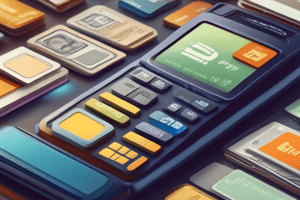Podcast
Questions and Answers
What characterizes E-Money transactions?
What characterizes E-Money transactions?
- Payment is done over a network without a middleman. (correct)
- They involve a middleman for processing payments.
- Payments are made solely in cash.
- They are only available for local transactions.
Which option is a requirement for secure e-payments?
Which option is a requirement for secure e-payments?
- Use of physical signatures for validation.
- Immediate completion of all transactions.
- Transparency in transaction fees.
- Integrity of information during transmission. (correct)
How is a user authenticated in e-payment systems?
How is a user authenticated in e-payment systems?
- Through email verification only.
- By their transaction history.
- With a physical ID check at a bank branch.
- By using a mechanism that verifies their identity. (correct)
What happens during an Electronic Fund Transfer (EFT) if the accounts are in different banks?
What happens during an Electronic Fund Transfer (EFT) if the accounts are in different banks?
Which principle ensures that information is only accessible by authorized users during transmission?
Which principle ensures that information is only accessible by authorized users during transmission?
What is the primary advantage of electronic payment systems over manual processing?
What is the primary advantage of electronic payment systems over manual processing?
What is the role of encryption in secure e-payments?
What is the role of encryption in secure e-payments?
What does non-repudiation in e-payments protect against?
What does non-repudiation in e-payments protect against?
Which of the following is NOT a mode of electronic payment?
Which of the following is NOT a mode of electronic payment?
What immediate action occurs after the amount is transferred to another account?
What immediate action occurs after the amount is transferred to another account?
In the credit card payment process, which entity pays on behalf of the customer initially?
In the credit card payment process, which entity pays on behalf of the customer initially?
What is a key difference between debit cards and credit cards?
What is a key difference between debit cards and credit cards?
Which component is associated with the merchant in a credit card transaction?
Which component is associated with the merchant in a credit card transaction?
What is the primary function of the microprocessor chip in a smart card?
What is the primary function of the microprocessor chip in a smart card?
What distinguishes electronic fund transfer (EFT) from other electronic payment methods?
What distinguishes electronic fund transfer (EFT) from other electronic payment methods?
Which card type deducts funds immediately from a bank account during a transaction?
Which card type deducts funds immediately from a bank account during a transaction?
Flashcards are hidden until you start studying
Study Notes
E-Commerce Overview
- E-Commerce involves electronic payment systems facilitating paperless monetary transactions.
- Electronic payments streamline business processes, reducing paperwork, transaction costs, and labor expenses.
- User-friendly and time-efficient electronic methods support organizations in expanding their market reach.
Modes of Electronic Payments
- Credit Card: Plastic card linked to an account; undergoes transactions without immediate payments from the user.
- Debit Card: Similar to credit cards but requires a bank account; funds are deducted immediately upon transaction completion.
- Smart Card: Contains a microprocessor to store personal and work-related information; offers added functionality beyond basic transactions.
- E-Money: Digital currency allowing online transfers between financial institutions without intermediaries, enhancing speed and efficiency.
- Electronic Fund Transfer (EFT): A process for transferring money between bank accounts; initiates via bank online services.
Credit Card System
- Cardholder: The customer using the credit card.
- Merchant: Seller who accepts credit card payments.
- Card Issuer Bank: Bank that issues the credit card to the customer.
- Acquirer Bank: Merchant's bank that accepts the credit card transaction.
- Card Brand: Networks like Visa or MasterCard that facilitate transactions.
Debit Card Features
- Requires a linked bank account for use.
- Instant deduction of funds from the user's bank account upon transaction.
Smart Card Attributes
- Resembles credit and debit cards but includes a microchip for additional data storage.
Electronic Fund Transfer Process
- Customers can transfer funds online to other bank accounts, regardless of whether they are in the same bank.
- Involves logging into a bank's website, registering the recipient's account, and requesting fund transfers.
Security Systems for E-Payments
- Confidentiality: Data should remain inaccessible to unauthorized parties; protection against interception is crucial.
- Integrity: Information must remain unaltered during transmission.
- Availability: Information needs to be retrievable within specified time frames.
- Authenticity: A system must authenticate users before access is granted.
- Non-Repudiation: Ensures that senders cannot deny having sent a message, and recipients cannot deny receiving it.
- Encryption: Information should be securely encrypted and accessible only to authorized users.
Studying That Suits You
Use AI to generate personalized quizzes and flashcards to suit your learning preferences.




